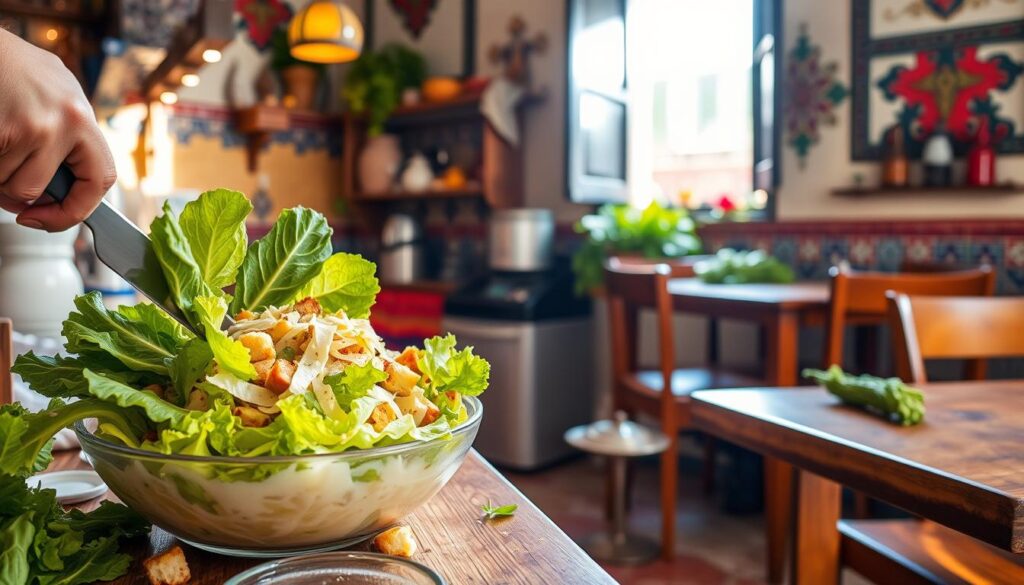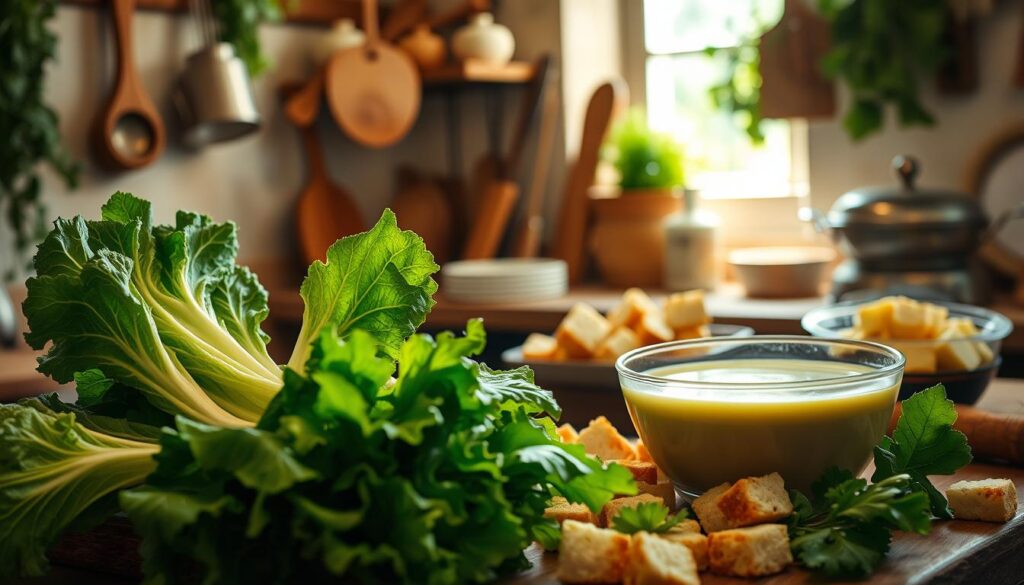Why Caesar Salad Called That? Every famous dish has a story, and why Caesar salad called that stands true. Imagine a lively Tijuana restaurant during Prohibition, where a new dish was born, changing menus everywhere. This fascinating origin tale reveals how Caesar salad earned its name and became a beloved staple around the world.
Caesar Cardini, an Italian immigrant, sparked this culinary revolution. He turned a simple dish into a global hit. This salad’s journey from Tijuana to fine dining restaurants is truly remarkable.
As we near the 100th anniversary of the Caesar salad in 2024, we’ll learn about Caesar Cardini’s kitchen magic. This salad’s story is one of chance and creativity. It’s a piece of culinary history.
The Birth of an Iconic Salad in Tijuana

Imagine a dish born from creativity during the Prohibition era. The caesar salad’s origin is linked to Tijuana’s lively past. In 1924, on Avenida Revolución, a story began that would change food forever.
Prohibition’s Unexpected Culinary Gift
During Prohibition, Americans went to Tijuana for fun and drinks. The caesar salad’s history started in this lively border town. Italian immigrant Caesar Cardini ran a famous restaurant there.
Cardini’s place drew Hollywood stars and travelers wanting to dodge American alcohol laws.
Caesar’s Restaurant: A Culinary Landmark
Caesar’s Restaurant was a hit, first in a charming alley and then on 2nd Street. The story of the caesar salad’s creation is one of quick thinking. With ingredients running low, Cardini mixed what he had to make a legendary dish.
- Opened in 1923 in Tijuana
- Relocated to Avenida Revolución in 1931
- Became a hotspot for tourists and celebrities
The Original Restaurant Atmosphere
Imagine a place with checkered floors and walls with Cardini’s picture. Waiters made salads right at your table. The Hotel Caesar sells about 2,500 Caesar salads every month, keeping the tradition alive.
This year, we celebrate the 100th anniversary of the ensalada Caesar. It shows how much this salad has influenced food.
Meet Caesar Cardini: The Italian Immigrant Behind the Legend

Caesar Cardini was more than a chef. He was a culinary genius who made a simple salad famous worldwide. Born in Italy, he moved to North America in the 1920s. He opened restaurants in Sacramento, San Diego, and Tijuana.
During Prohibition, Cardini’s restaurants in Tijuana became a hit. He and his brother Alessandro welcomed American tourists. They offered food and fun, away from U.S. alcohol laws.
- Italian immigrant with culinary ambition
- Restaurants spanning California and Mexico
- Innovator during Prohibition era
Cardini’s creativity led to the Caesar salad. On July 4, 1924, he made a salad with romaine lettuce, eggs, Parmesan cheese, and more. This mix became the famous Caesar salad, making Cardini a legend.
Hollywood stars loved the salad, making it famous fast. It went from a Tijuana favorite to a global dish. Cardini’s flair, like making it at the table, made it even more special.
Why Caesar Salad Called That: The Original Recipe’s Key Components
Explore the world of the classic Caesar salad. It’s a mix of simple yet amazing ingredients. This journey shows a history of flavor and innovation.
The Caesar salad recipe started as a quick fix in a busy kitchen. Its ingredients tell a story of creativity. This story has won the hearts of food lovers for years.
Traditional Ingredients
A true Caesar salad is all about simplicity. Its ingredients reflect the creator’s love for fresh, quality food. Let’s look at the classic recipe:
- Crisp romaine lettuce
- Freshly grated Parmesan cheese
- Homemade croutons
- Coddled eggs
- Garlic-infused olive oil
- Fresh lemon juice
- Worcestershire sauce
The Tableside Preparation Method
The salad’s unique touch was its dramatic preparation. Chefs would mix the ingredients right before your eyes. This made the dining experience more exciting.
The Role of Anchovies Controversy
Interestingly, the original recipe didn’t have anchovies. Worcestershire sauce added a subtle fishy flavor. Later, some chefs added anchovies, starting a long debate about the salad’s true form.
Now, you see the Caesar salad as more than a recipe. It’s a peek into a rich culinary tradition that delights people everywhere.
Why Caesar Salad Called: The Story Behind the Name
Ever wondered why Caesar salad is so named? The story is as intriguing as the salad itself. It was named after Caesar Cardini, who created it during the Prohibition era.
The salad’s origins date back to July 4, 1924, in Tijuana, Mexico. Caesar Cardini, an Italian immigrant, made it when ingredients were scarce. His quick thinking turned it into a worldwide favorite.
- The salad was named directly after its inventor
- Created at Caesar’s restaurant on Avenida Revolución
- Became a symbol of inventive cuisine
Why is it called after Caesar? It’s because of how he prepared it. He mixed the ingredients right at the table. This made the salad memorable and tied his name to it.
Now, about 35% of U.S. restaurants have Caesar salad on their menus. This shows how Cardini’s salad has stood the test of time. Its fame soared after it was featured in the 1951 “Joy of Cooking” cookbook.
Today, the Caesar salad is a tribute to its creator. It stands for creativity, simplicity, and tasty innovation.
From Border Town to Global Fame: The Salad’s Journey
The story of the caesar salad is truly amazing. It started as a simple dish in Tijuana and soon became a hit worldwide. The salad’s origins are tied to the lively food scene of the 1920s.
Hollywood’s Influence
Movie stars were key in making the caesar salad famous. They loved Caesar Cardini’s restaurant and talked about the salad everywhere. Los Angeles was the first big city to try it outside of Mexico.
- Movie stars popularized the salad during frequent trips to Tijuana
- Restaurant owners in California began featuring the dish
- The salad became a symbol of cosmopolitan dining
International Recognition:Why Caesar Salad Called
By the 1950s, the Caesar salad was known all over. Travelers and food lovers helped it spread. Restaurants from New York to Paris started their own versions of this classic dish.
- Spread across North American restaurants
- Gained popularity in European culinary circles
- Became a staple in fine dining establishments
Now, Caesar salad is in about 35% of U.S. restaurants. This shows its lasting appeal. It went from a small Tijuana kitchen to a global favorite.
Evolution of Caesar Salad Through Decades
The Caesar salad has had a remarkable journey. It started in Tijuana and has become a big hit in the United States. It’s a story of how a simple salad became a favorite among food lovers.
In the 1950s, the salad became famous after being in “Joy of Cooking.” Chefs in the 1960s and 1970s made it even more special by making the dressing right at your table. This added a fun element to dining out.
- 1950s: Cookbook recognition and growing popularity
- 1960s-1970s: Tableside preparation becomes a dining spectacle
- 1980s-1990s: Experimental variations emerge
Today, chefs are trying new things with the Caesar salad. They add different ingredients:
- Kale-based versions
- Protein-enhanced editions (chicken, salmon)
- Alternative dressings like miso or tofu-based options
Even with all these changes, the Caesar salad stays true to its roots. It’s a mix of fresh romaine, tasty dressing, and savory bits. It’s loved in fancy restaurants and cozy cafes alike. The Caesar salad shows that some dishes are truly timeless.
By 1953, the International Society of Epicures in Paris called it the “greatest recipe to originate in the Americas in the past 50 years.” This shows how much people love it and how important it is in cooking.
The Art of Tableside Preparation
The Caesar salad’s charm goes beyond its ingredients. Its preparation was once a show that made dining special. When chefs first did it tableside, it changed how restaurants served food.
Traditional Presentation Techniques
In the early days, chefs made the salad right before guests’ eyes. The ritual included:
- Using a large wooden bowl
- Mixing ingredients with flair
- Crushing garlic and anchovies
- Whisking dressing right there
This wasn’t just about food. It was a show that made dining more than just eating. It turned it into a fun, interactive experience.
Modern Serving Methods
Even though many places don’t do it anymore, some fancy restaurants are bringing it back. Today’s chefs mix old traditions with new ways, showing guests the salad’s history.
- Some keep the traditional wooden bowl mixing
- Others do deconstructed Caesar salad presentations
- Chefs try new ingredient combinations
The art of Caesar salad making is always changing. It keeps the spirit of its creation alive in today’s kitchens.
Impact on American Dining Culture
The Caesar salad changed American dining, turning salads into main events. Its history shows a journey that won over diners across the U.S.
In the 1950s and 1960s, the Caesar salad was seen as fancy. Places like Romanoff’s and the Hollywood Brown Derby made it popular. It became a key part of fancy meals and power lunches.
Key impacts on dining culture included:
- Popularizing tableside preparation as an entertainment element
- Introducing more complex flavor profiles to mainstream dining
- Bridging health-conscious eating with indulgent ingredients
- Creating a versatile dish adaptable to multiple cuisines
The salad’s roots are in Italian cooking, mixed with American tastes. Today, about 35% of U.S. restaurants offer Caesar salad. This shows its lasting appeal.
It’s been amazing how the salad has evolved. From the original to chicken Caesar or kale Caesar, it keeps getting new twists. Almost 43 million bottles of Caesar salad dressing are sold each year. This highlights its big role in American food culture.
The Caesar salad is more than a dish. It’s a symbol of creativity, simplicity, and the ever-changing American food scene.
Modern Interpretations and Variations
The Caesar salad has changed a lot from its start in Tijuana. Today, chefs are trying new things while keeping the dish’s essence.
Now, the Caesar salad is exploring new flavors. Chefs are adding unique twists that make diners curious and open to new tastes.
Contemporary Culinary Innovations
Modern Caesar salads come with exciting flavors:
- Miso-infused dressings
- Tequila-spiked preparations
- Lemongrass-enhanced versions
- Non-traditional protein additions like tandoori prawns
- Buffalo-cauliflower fritter variations
Popular Restaurant Adaptations:Why Caesar Salad Called
Restaurants in the U.S. are getting creative with Caesar salads. Some stick to the classic, while others mix in global flavors.
Even with all the changes, critics say a true Caesar salad must have key elements. These include garlic, acidic notes, umami depth, crisp romaine leaves, hard cheese, and satisfying crunch.
The Caesar salad’s lasting popularity shows its flexibility and appeal in today’s American food scene.
The Legacy of Caesar’s Restaurant Today
Caesar’s Restaurant in Tijuana is a key spot in the world of food. It keeps alive the story of the Caesar salad, which started nearly a century ago. This place, where César Cardini first made his famous salad, is now a must-visit for food lovers everywhere.
In 2024, the restaurant will mark a big milestone – the 100th year of the Caesar salad. The festival to celebrate this will be a big event. It will show how important this salad is to our culture.
- Four-day celebration on Avenida Revolución
- Featuring renowned chefs from multiple countries
- Wine tasting and special dinners
- Live music and cultural performances
The restaurant has grown but kept its old charm. After being bought by Grupo Plascencia in 2011, Caesar’s started using better ingredients. They now use Parmigiano Reggiano from Italy instead of the old stuff.
Food experts and critics keep coming back to pay their respects. They visit the place where the Caesar salad was born. The salad is made tableside by skilled chefs, keeping the tradition alive for everyone to enjoy.
This celebration is not just about the salad. It also shows off Tijuana’s amazing food culture. It’s turning the city into a top spot for food lovers from all over.
Conclusion
The Caesar salad’s story is more than just a dish. It started in Tijuana, Mexico, and has changed how we eat around the world. Caesar Cardini’s name is on it because of his creativity in the 1920s.
Looking into the Caesar salad’s history shows how a simple recipe became a global hit. It went from a small town dish to a favorite in the U.S. and everywhere else. Its flexibility lets chefs keep it fresh while keeping its essence.
Food lovers everywhere enjoy the Caesar salad for its mix of tastes and textures. It’s loved as a side or a main dish. Its enduring popularity shows that amazing food can bring people together.
The Caesar salad’s story is a testament to the power of culinary creativity. It went from a Tijuana kitchen to tables worldwide. It’s a tasty symbol of how food can bridge cultures and generations.

